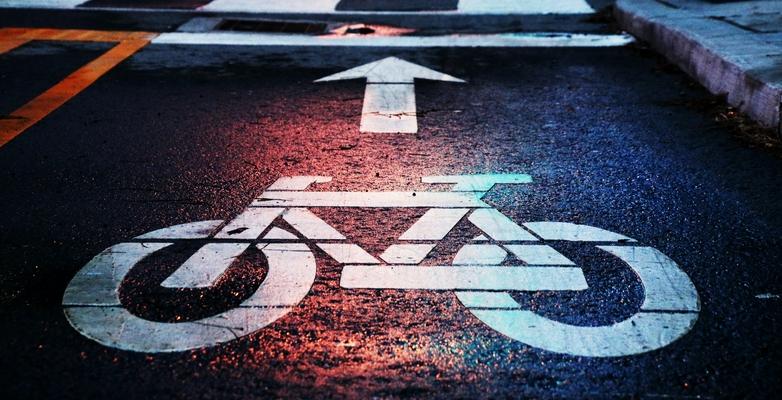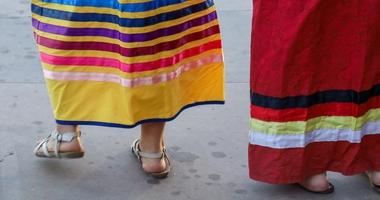
Why Bicycle Advocacy Must Go Beyond Infrastructure
Jumping on a bicycle may seem like an easy way to reduce emissions. But who is able to enjoy the full benefits of cycling — and how we can expand access — is much more complicated.
If you want to understand the knotty complexity of making the transition to a sustainable and net-zero world a truly just one, start by looking at bike lanes.
By now, of course, most of us have heard something like: "Want to make a difference on emissions? Get out of your car and ride a bike."
No well-intentioned listicle on cutting your carbon footprint goes without it. And the image it conjures has a certain beauty to it for most of us in car culture USA, evoking both that American virtue of self-reliance and a throwback to a romanticized life without traffic jams and cities choked with smog.
Add that to findings like those from one recent study reporting that choosing to pedal instead of drive just once a day (for those who have the option) can cut the average person's transport emissions by 67%, and well, what's not to love?
Well, a few things, actually. Putting aside the fact that the idea of a carbon footprint was born as a fossil fuel marketing ploy designed to shift blame from the oil companies driving climate change onto the people guilty of living in the world they created, it's not quite so simple.
Not All Bike Infrastructure Is Created - Or Equal
As anyone who rides a bike in traffic will tell you, riding a bike means you're physically exposed to risks - without the added security blanket of tons of metal - that most drivers never think twice about it.
No surprise then, for many people, one of the first questions that comes up around riding a bike is "Is it safe enough?"
For some communities, building dedicated bike lanes in city streets is one way to make cycling safer. But not every neighborhood gets the same treatment or opportunities. In fact, research shows that overall, communities of color not only have less bike infrastructure in their neighborhoods, but also more dangerous street design.
It's hard not to connect the dots between the lack of investment and infrastructure and a new study that found that Black cyclists are 4.5 times more likely to die from traffic violence than white cyclists. And these trends extend to other racially marginalized groups.
But the need for more biking infrastructure is just one piece of puzzle.
Beyond Bicycle Infrastructure
Low-income communities and communities of color experience additional barriers that can make it difficult to safely ride a bike.
In a Rutgers University study, Black and Latino survey respondents reported that after a fear of a traffic collision, their most common barriers to biking were pavement condition, fear of being stranded, and a fear of being racially profiled by the police.
In addition to experiencing higher rates of traffic violence, studies also show that cyclists of color are disproportionately ticketed. A 2021 study conducted by University of California assistant professor Jesus Bajaras looked at racial disparities in ticketing in Chicago and found that cyclists in Black neighborhoods were eight times more likely to be ticketed by cops than in white neighborhoods. Cyclists in Latino neighborhoods were three times more likely to be ticketed. Many of the tickets were for riding on sidewalks.
Julian Agyeman, a professor of urban and environmental policy and planning at Tufts University, co-authored an article called “‘You want protected bike lanes, I want protected Black children. Let’s link’: equity, justice, and the barriers to active transportation in North America*.”
The barriers that communities of color face in accessing bicycling extend beyond a lack of safe infrastructure, he said in an interview.
“A large part of the answer is not due to physical infrastructure; it's due to what we might call social or cultural infrastructure,” Agyeman said. “A lot of Black and brown people are frightened to go outdoors because of security issues in their neighborhoods, because of the fear of police action. We know the data on jaywalking. We know the data on cycle citations. We know the data on traffic accidents and people of color, and it's not encouraging.”
Bike Lanes Become ‘White Lanes’
There is plenty of evidence that bike lanes can make streets safer for cyclists. One study by researchers at University of Colorado Denver found that protected bike lanes don’t just reduce accidents that involve cyclists, they also reduce motor vehicle collisions.
But in some BIPOC and low-income communities, bike lanes serve as symbols of gentrification. Young professionals and city leaders may see economic growth and development activity as signs of improvement. However, to long-time residents of communities who have experienced the negative effects of disinvestment, street infrastructure improvements can instead signal the emergence of rising rents and displacement.
White, wealthier neighborhoods often also have more bike infrastructure. Professor Bajaras’ study also found that bike infrastructure was “disproportionately absent from Black and Latino neighborhoods.” In her book, “Bike Lanes are White Lanes,” author and scholar Melody L. Hoffman writes that “by governments focusing on bicycle infrastructure that will please an already privileged demographic, many marginalized bicyclists will inevitably remain in the margins.”
In cities across the US, current inequities can be traced back to a history of racist and exclusionary policies, such as redlining. For example, many of Minneapolis’s most celebrated parks were designed to be surrounded by white residential districts, and planning was used as a tool to reinforce and create racial inequities, rather than combat them.
Currently, even the way that city governments determine a need for bike infrastructure can be inequitable. City planners’ counts of cyclists in “any given area may provide data on usage,” but the gender, ethnicity, or race of the cyclists are often not recorded, despite the fact that the data is used to gauge where there is a need for bike infrastructure.
Cyclist counts also often take place in downtown areas, which may not be where marginalized groups do the bulk of their cycling. This can cause these cyclists to be left out of official data, and consequently, out of future infrastructure projects.
Not Just Consultation, But Co-Production
Just as the barriers to biking are complex, so are the ways we can break them down. As we work to make to make active transportation more accessible, and transition away from fossil fuels, equity must be at the center of planning processes. Solutions to increasing access should come from the ground up – and center the experiences and barriers that BIPOC communities face when it comes to cycling, such as disproportionate interactions with police.
Across the country, BIPOC-led groups such as The Untokening, People for Mobility Justice, and Equiticity are defining what mobility justice means to them.
In an interview with CityLab, mobility justice strategist and urban anthropologist Adonia Lugo said that in the mainstream bicycle advocacy movement, there is a strong focus on bicycle infrastructure, which “unfortunately treats cities as though they are homogenous, as if the populations in them are going to relate to street design changes in the same predictable way.”
But things are much more complicated. And these often white spaces can overlook other ways we can increase access to cycling. Lugo said we must also pay attention to “human infrastructure” and allocate resources toward spaces and programs that allow people to come together and develop “their own narratives of what bicycling means.” She said, for example, that youth programming focused on bicycle building and repair is just one example of what could be publicly funded. She also said bicycling could be linked with existing job education and workforce development programs.
Professor Agyeman said in his interview that we must also take a critical look at who makes planning decisions – and how this kind of work is approached.
“The number one reason why these broader cultural and social infrastructural issues are not discussed is if you take a look at: who are the transportation committees? Who are the planners? They don't look like America,” he said. “A lot of the time, people are planning on behalf of communities. They're doing it for the community. Well, I want to see co-produced ideas.”
What the Climate Movement Can Learn
From the outside, it seems like it should be easy. Just get on your bike and help us all reduce emissions. But it's not that simple for everyone and without a thoughtful and comprehensive approach that involves everyone impacted, what looks like a solution can end up doing a whole lot of harm.
The climate movement should take note as we work for the kind of energy transition that genuinely benefits everyone, and doesn't simply replace the fossil fuels behind so much disparity in the US with a friendlier technology.
It starts with real co-production of ideas and approaches to solutions. So, with major climate opportunities ahead with the passage of the Inflation Reduction Act, policymakers and activists looking to jumpstart a just energy transition could start by doing the simplest and most important thing when it comes to the communities they want to serve and fight for: Listen.
To stay in the loop with all the key developments in our fight for just climate solutions, sign up for our email activist list today.




